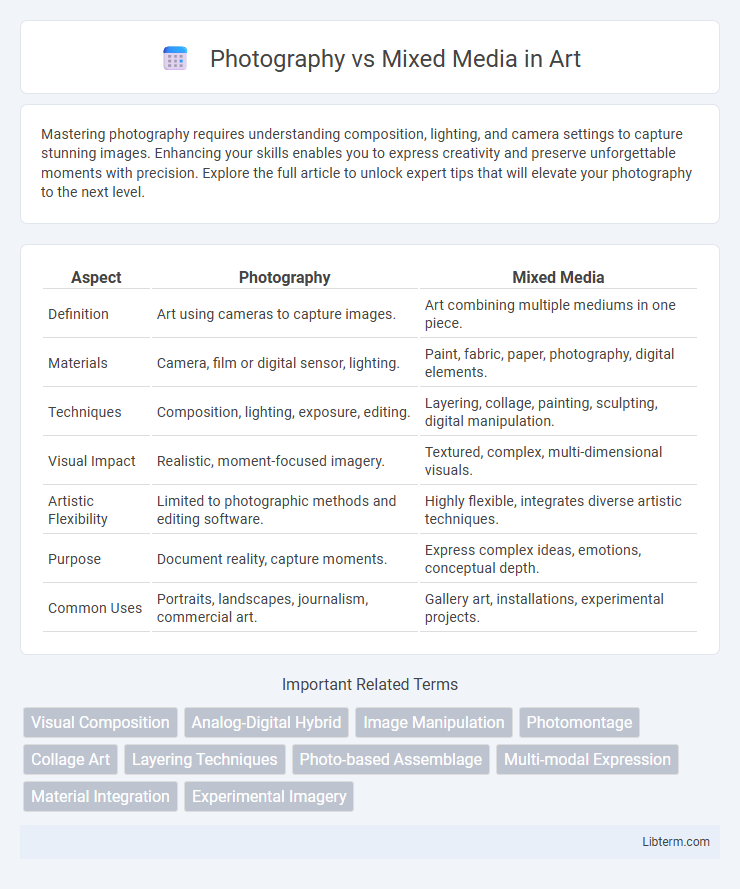Mastering photography requires understanding composition, lighting, and camera settings to capture stunning images. Enhancing your skills enables you to express creativity and preserve unforgettable moments with precision. Explore the full article to unlock expert tips that will elevate your photography to the next level.
Table of Comparison
| Aspect | Photography | Mixed Media |
|---|---|---|
| Definition | Art using cameras to capture images. | Art combining multiple mediums in one piece. |
| Materials | Camera, film or digital sensor, lighting. | Paint, fabric, paper, photography, digital elements. |
| Techniques | Composition, lighting, exposure, editing. | Layering, collage, painting, sculpting, digital manipulation. |
| Visual Impact | Realistic, moment-focused imagery. | Textured, complex, multi-dimensional visuals. |
| Artistic Flexibility | Limited to photographic methods and editing software. | Highly flexible, integrates diverse artistic techniques. |
| Purpose | Document reality, capture moments. | Express complex ideas, emotions, conceptual depth. |
| Common Uses | Portraits, landscapes, journalism, commercial art. | Gallery art, installations, experimental projects. |
Introduction to Photography and Mixed Media
Photography captures moments through lenses and light, using cameras to create images that document reality with precision and artistic intent. Mixed media combines photography with other artistic materials such as paint, collage, and digital elements, producing multi-layered works that explore texture and narrative beyond traditional photographic boundaries. Both mediums offer unique ways to express creativity, with photography emphasizing realism and mixed media inviting experimental fusion.
Defining the Art Forms: Photography vs Mixed Media
Photography captures images through cameras and lenses, emphasizing light, composition, and timing to create realistic or artistic representations. Mixed media combines various materials such as paint, paper, fabric, and photographic elements, resulting in textured, multi-dimensional artworks that transcend traditional photographic boundaries. Both art forms explore visual storytelling but differ in technique, medium, and expression scope.
Historical Evolution of Photography and Mixed Media
Photography emerged in the early 19th century with the invention of the daguerreotype in 1839, marking a revolutionary leap in visual documentation and art. Mixed media, dating back to ancient times but gaining prominence during the 20th century, combines various artistic materials and methods to create layered, dynamic compositions that challenge traditional boundaries. The historical evolution of photography, from analog to digital, intersects with mixed media by enabling artists to blend photographic imagery with painting, collage, and digital manipulation, expanding creative possibilities and artistic expression.
Techniques and Processes Compared
Photography relies on capturing images through lenses and sensors, emphasizing exposure, composition, and post-processing techniques like editing and retouching. Mixed media art combines photography with materials such as paint, collage, and digital elements, integrating various textures and layers to create multidimensional effects. Techniques in mixed media often involve blending traditional photography with manual interventions, expanding creative possibilities beyond the limits of standard photographic development.
Creative Expression: Similarities and Differences
Photography and mixed media both serve as powerful tools for creative expression, allowing artists to convey emotions and narratives through visual elements. Photography captures moments with precision and realism, emphasizing light, composition, and timing, while mixed media combines various materials and techniques, such as paint, collage, and digital elements, to create textured and layered artworks. Both mediums encourage experimentation and personal interpretation, but mixed media offers greater flexibility in integrating diverse textures and materials beyond the photographic image.
Impact on Visual Storytelling
Photography captures authentic moments with precise detail, creating powerful visual narratives grounded in reality. Mixed media combines photography with diverse artistic elements like painting, collage, or digital manipulation, enhancing emotional depth and symbolic complexity. This fusion broadens storytelling possibilities by allowing creators to layer multiple perspectives and textures, producing richer, more immersive visual experiences.
Audience Perception and Engagement
Photography captures reality through a single frame, often evoking immediate emotional responses by focusing on visual detail and composition, which appeals to audiences seeking clarity and authenticity. Mixed media art combines various materials and techniques, inviting viewers to engage more deeply by interpreting layered textures and meanings, thus fostering a more interactive and contemplative audience experience. Audience perception shifts with mixed media's multidimensionality, encouraging personal interpretation, while photography's direct representation offers a more universally accessible engagement.
Technology’s Role in Both Mediums
Technology has transformed photography by enabling digital sensors, advanced editing software, and AI-driven enhancements that expand creative possibilities and precision. In mixed media, technology integrates digital prints, laser cutting, and augmented reality, blending traditional materials with innovative tools to create dynamic, interactive artworks. Both mediums leverage tech advancements to push boundaries, allowing artists to explore new forms and engage audiences in novel ways.
Notable Artists and Influential Works
Notable artists in photography include Ansel Adams, renowned for his iconic black-and-white landscapes, and Cindy Sherman, famous for her conceptual self-portraits challenging identity and representation. In mixed media, influential figures such as Robert Rauschenberg revolutionized art by combining painting, photography, and found objects, exemplified in his "Combines" series. Both mediums continuously evolve through groundbreaking works that blend visual storytelling and innovative techniques.
Future Trends in Photography and Mixed Media
Future trends in photography emphasize AI-driven image enhancement, immersive 3D visuals, and the integration of augmented reality to create dynamic storytelling experiences. Mixed media is evolving through the fusion of traditional photography with digital art, holography, and interactive installations, pushing boundaries of sensory engagement and conceptual depth. Advancements in blockchain technology and NFTs are also transforming ownership and distribution models, fostering new market opportunities for both photographers and mixed media artists.
Photography Infographic

 libterm.com
libterm.com